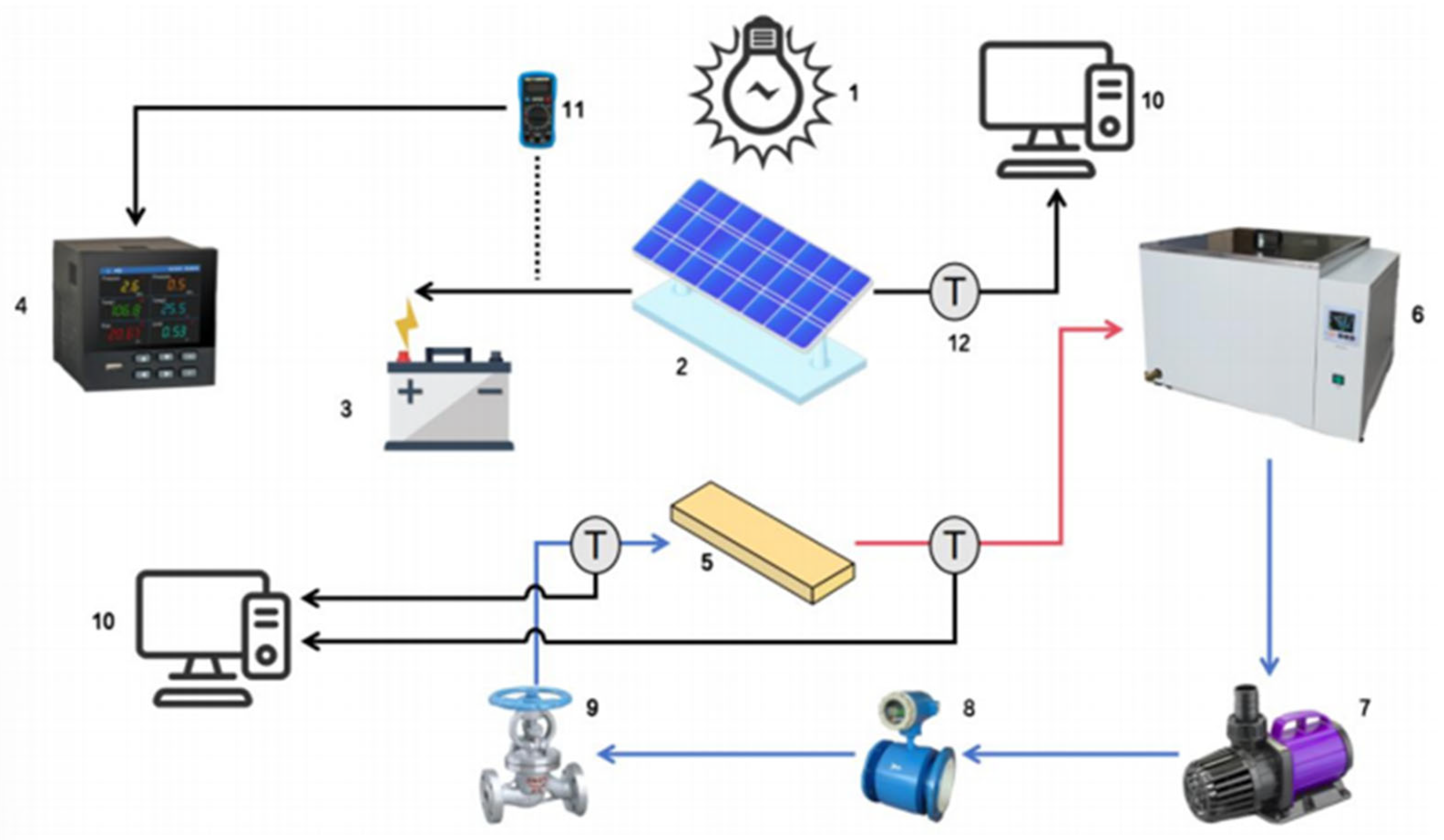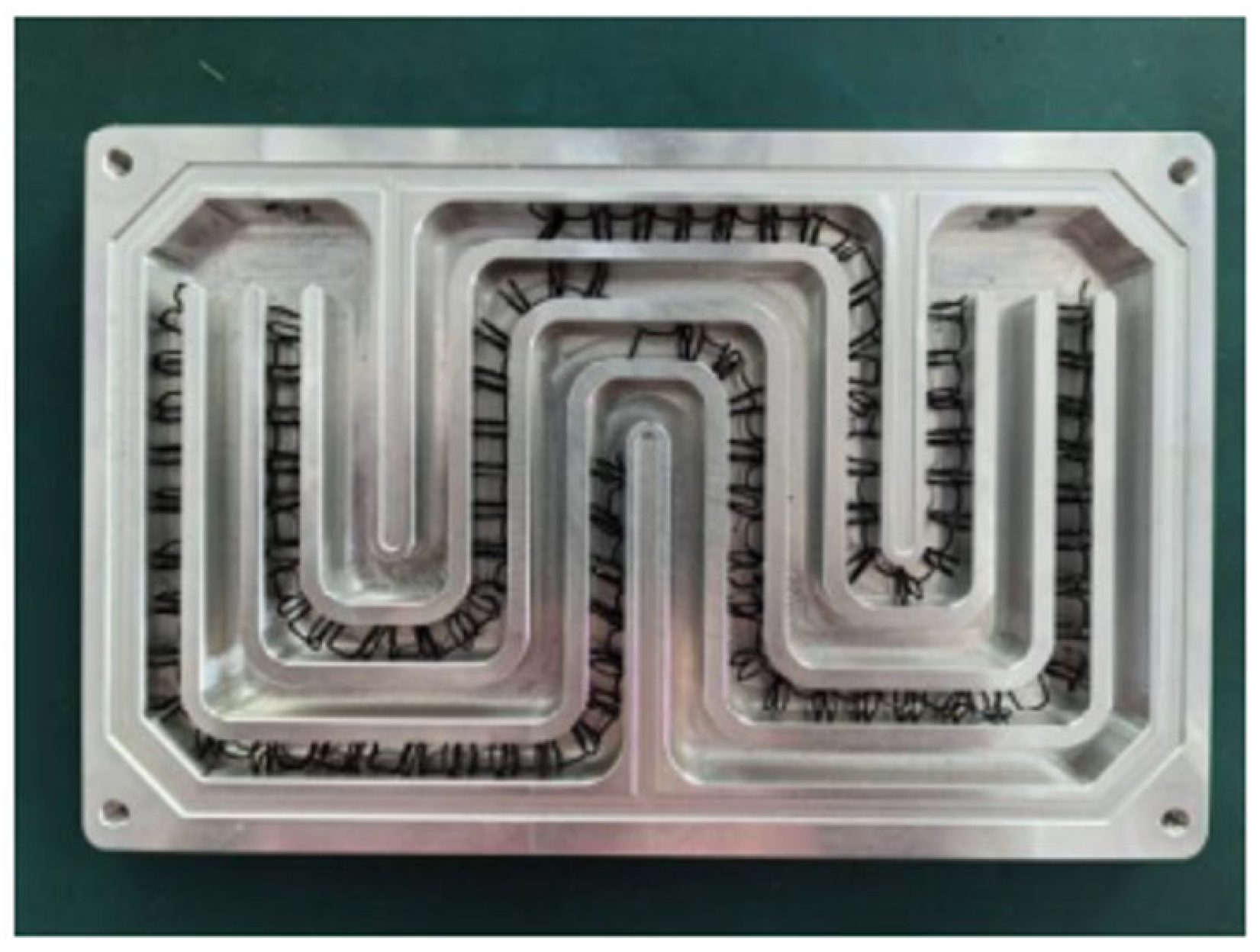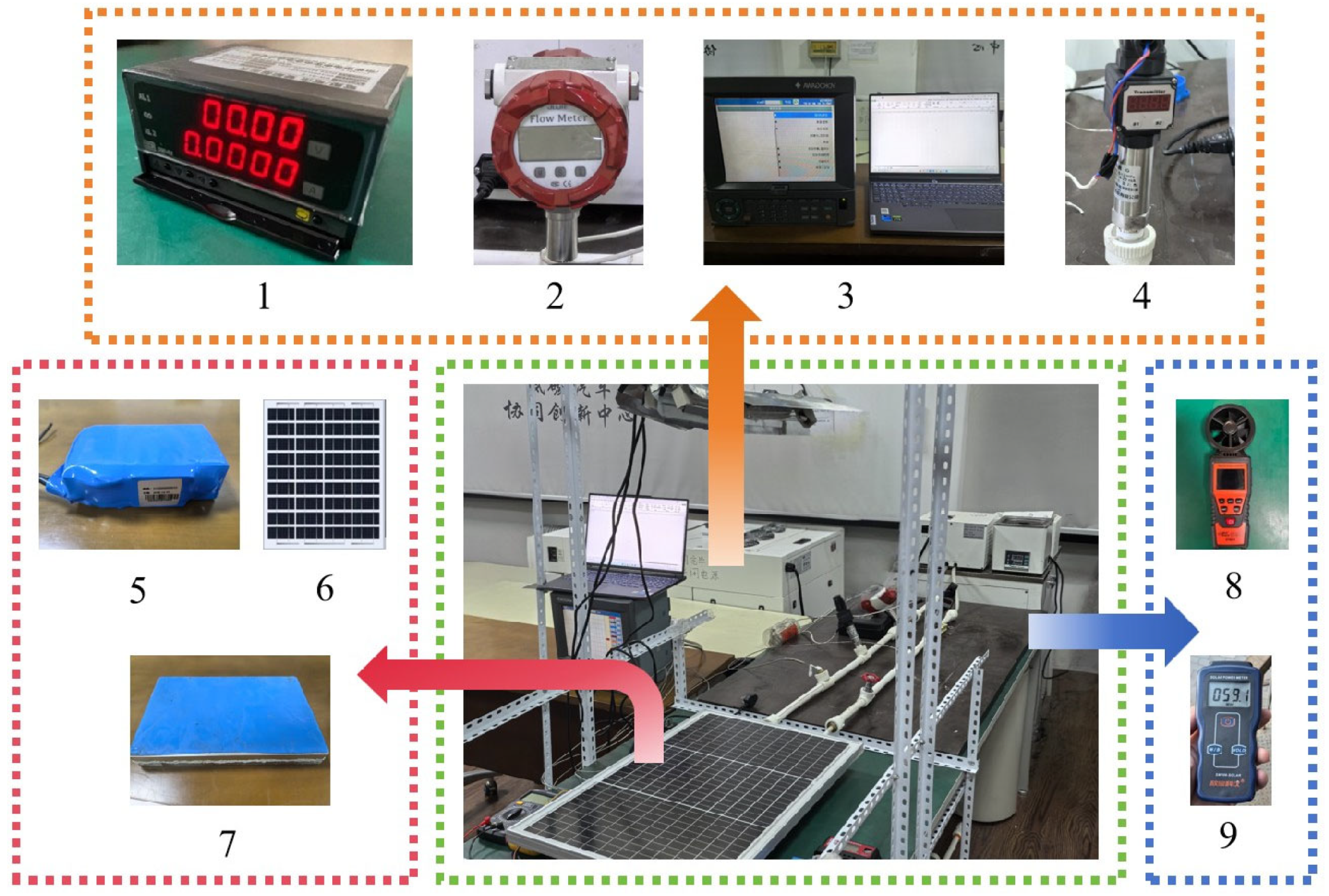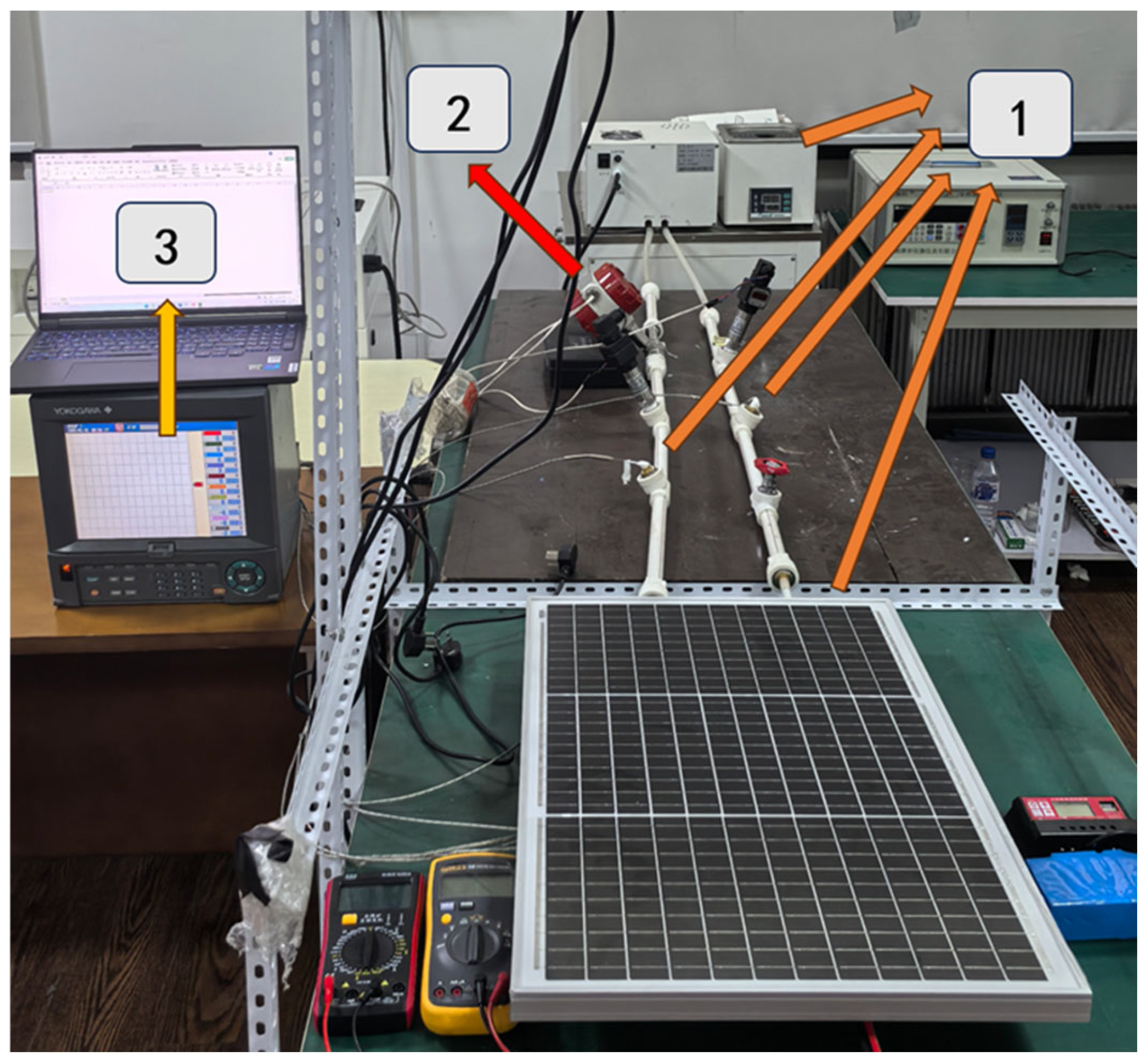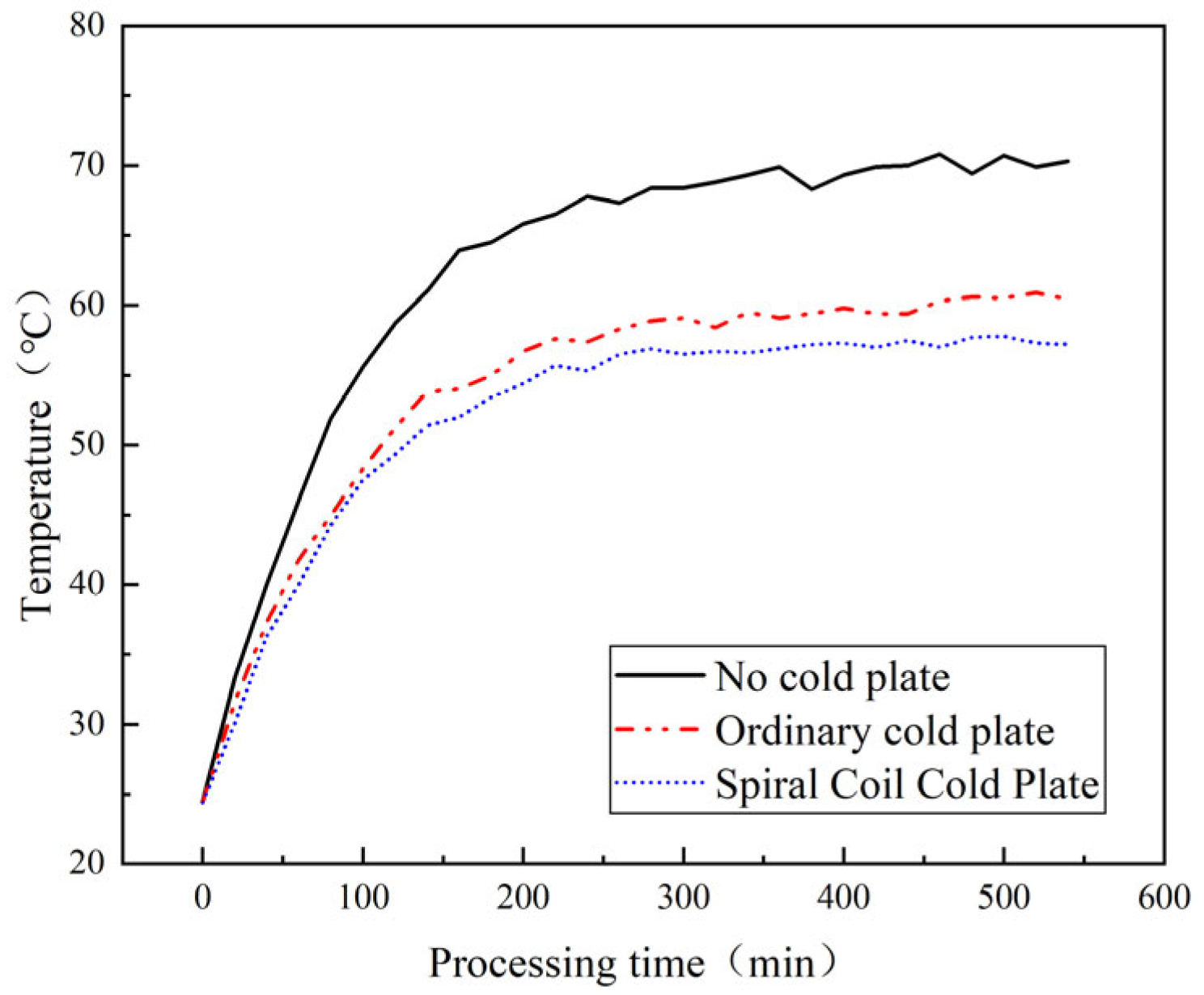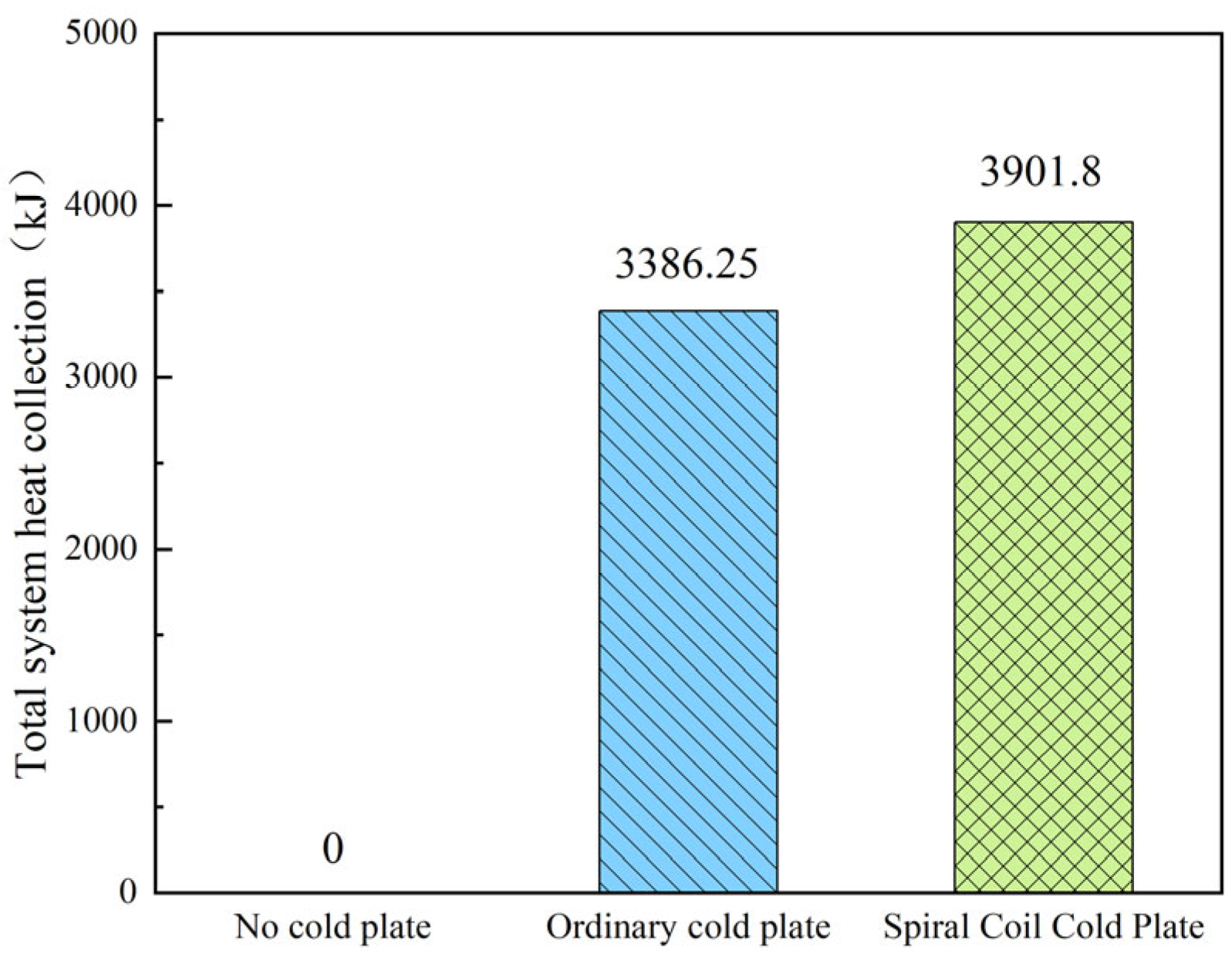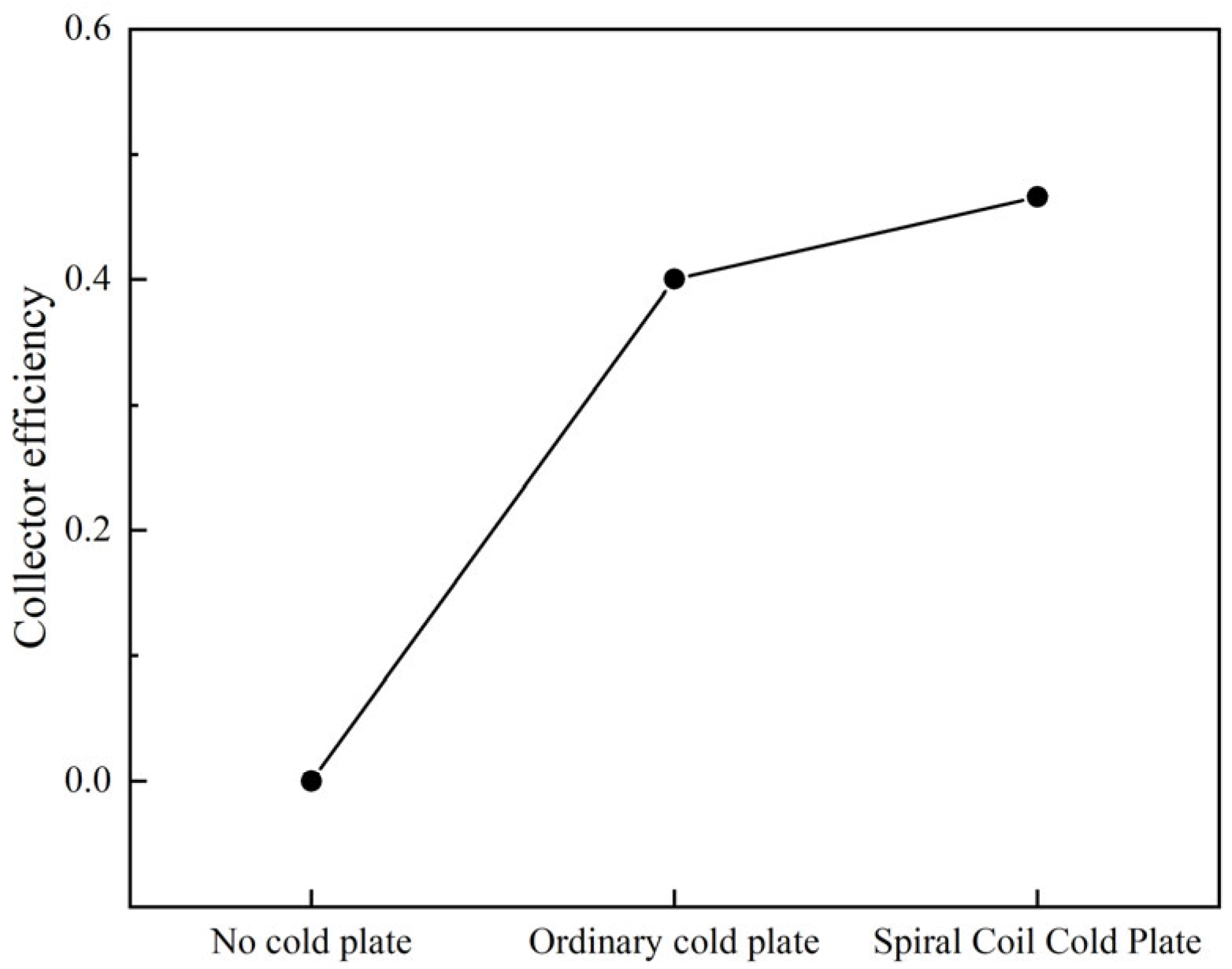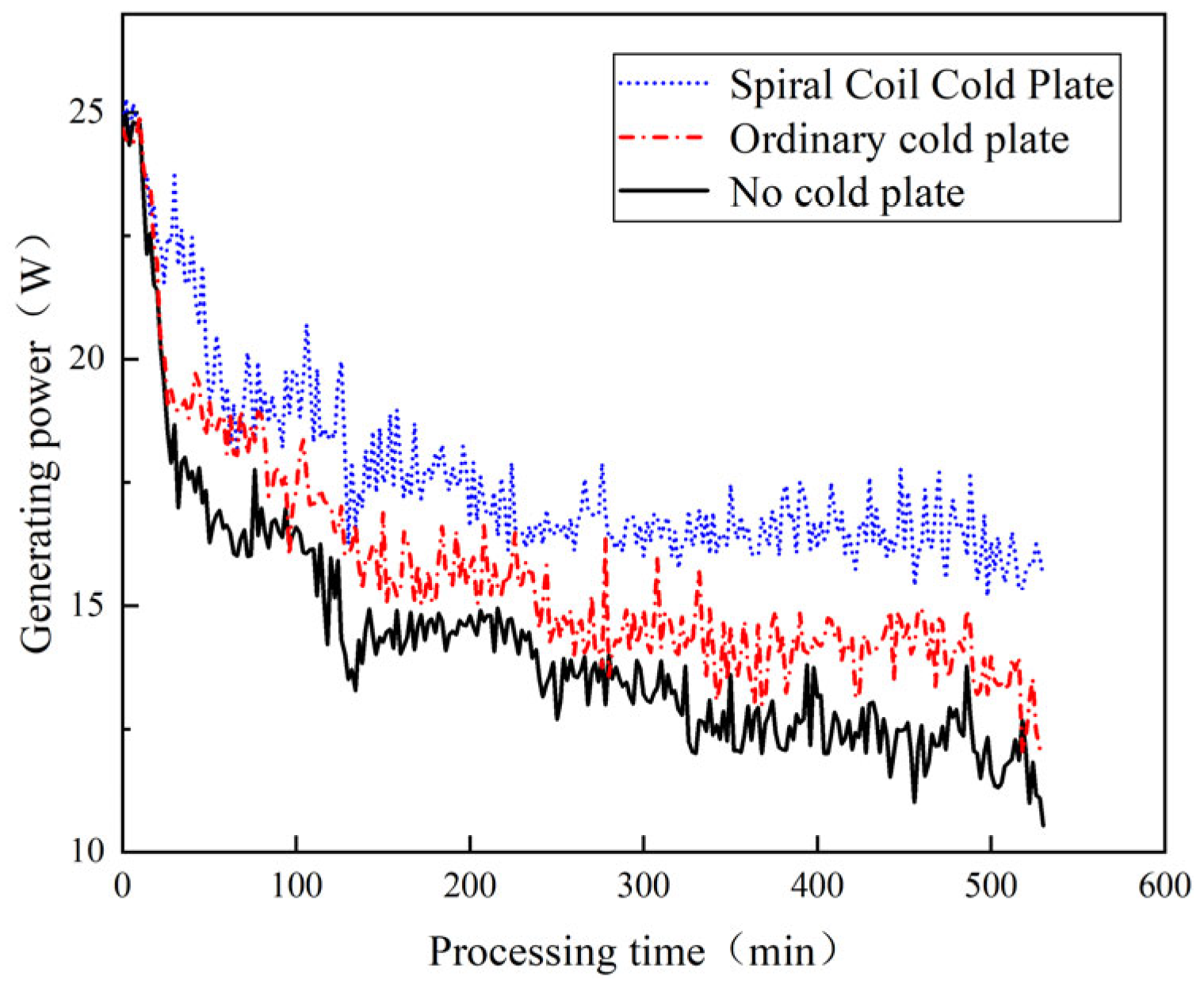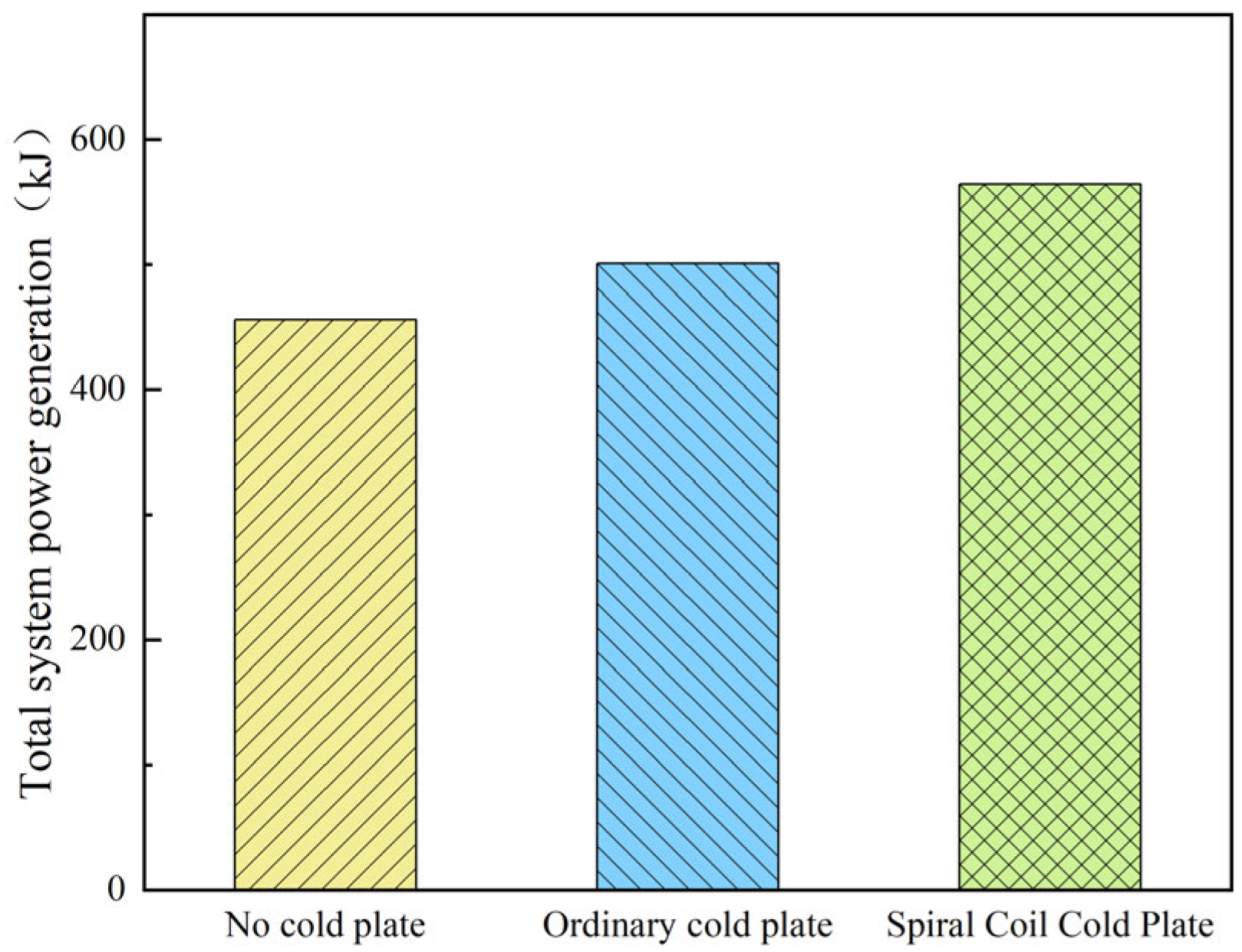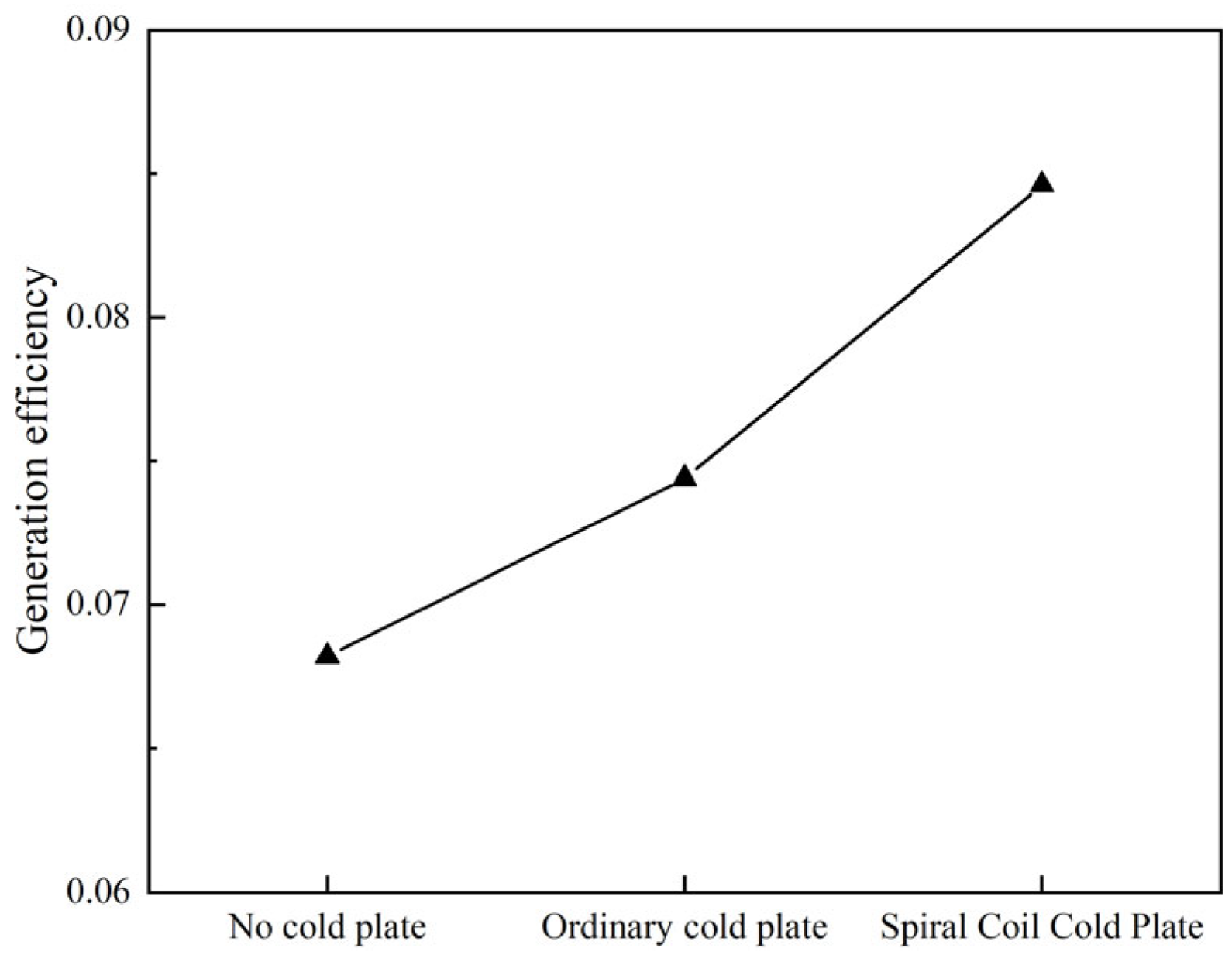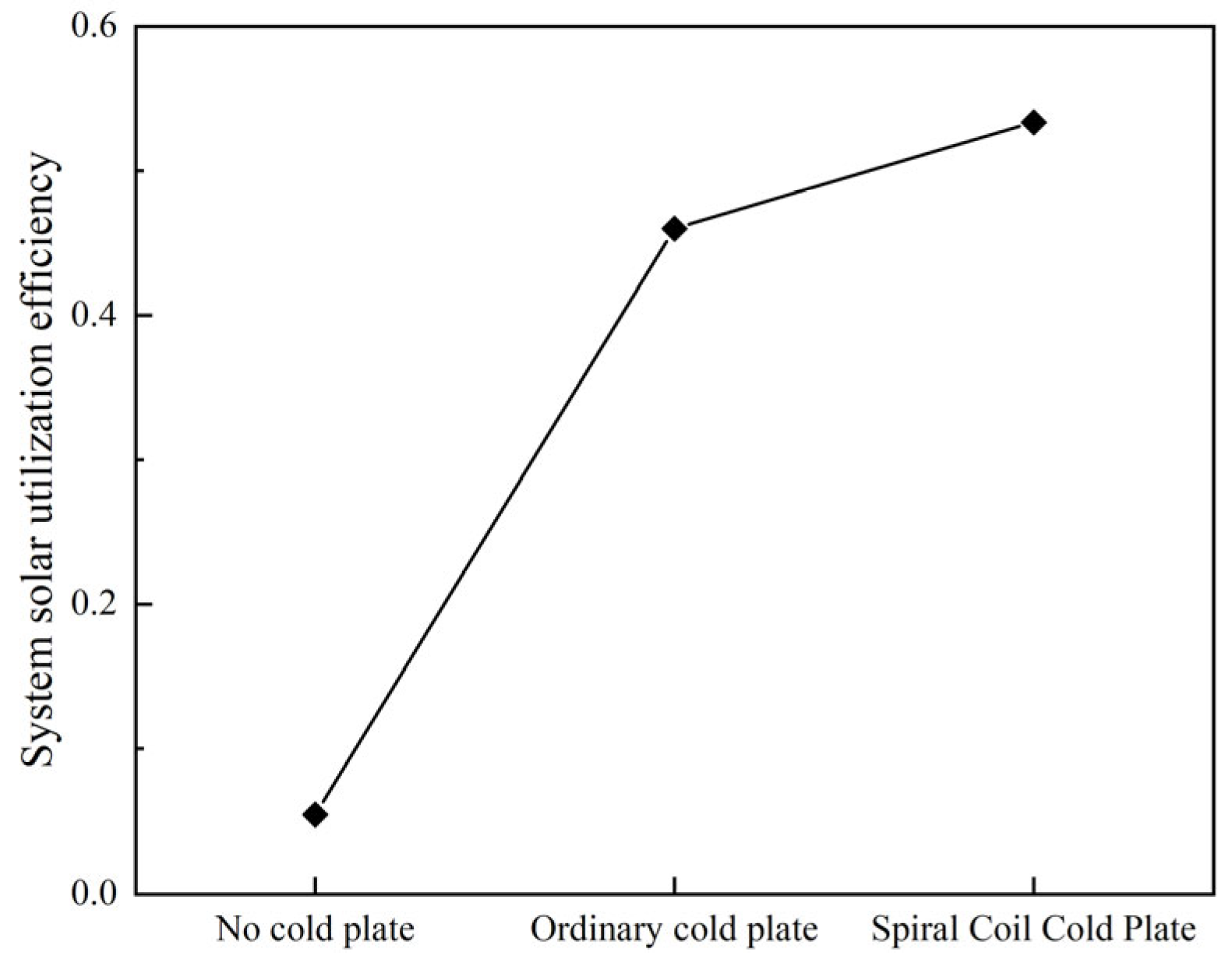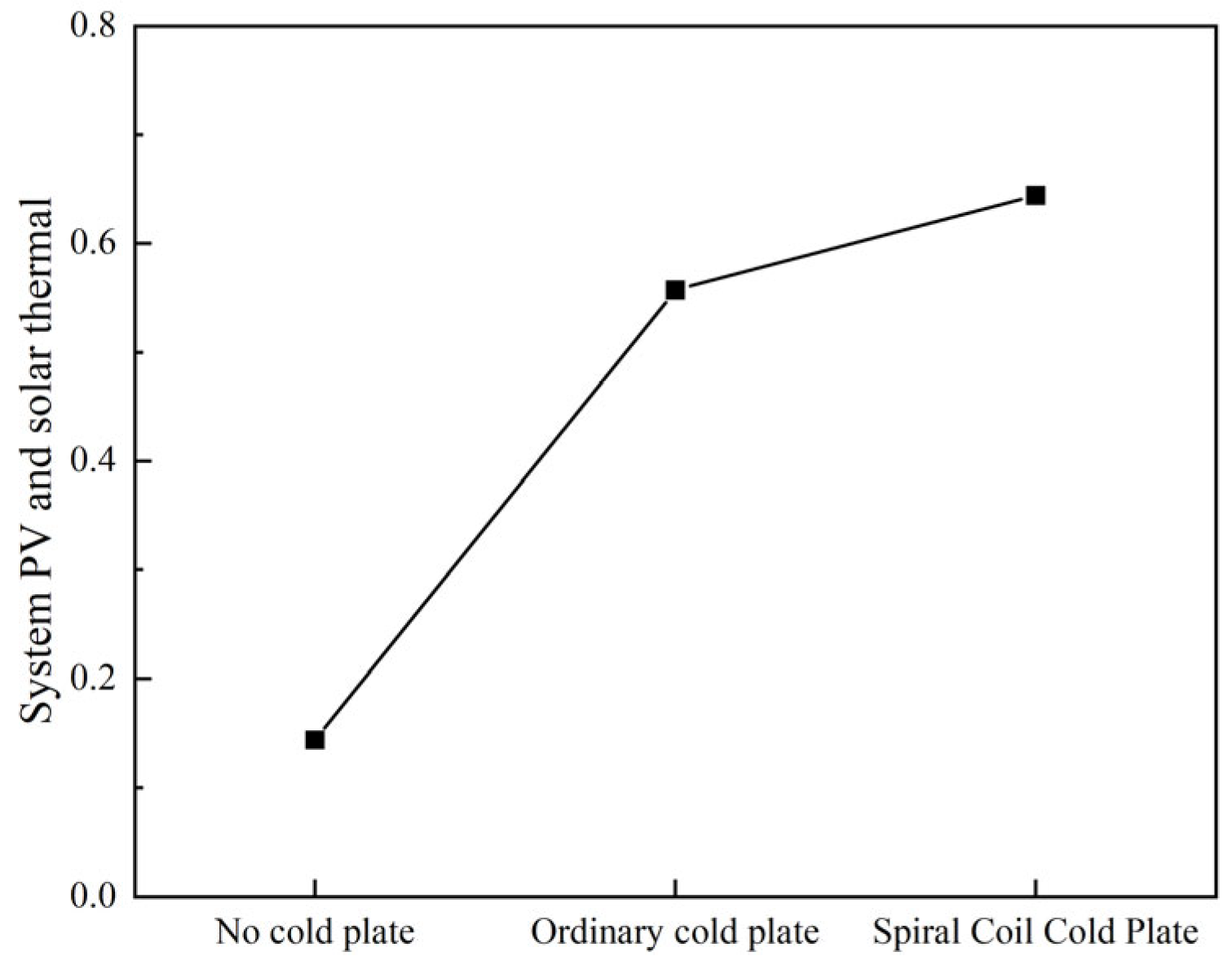1. Introduction
The confluence of dwindling fossil fuel reserves, volatile energy prices, and escalating global energy demand has rendered the development of clean and renewable energy sources a critical priority. Among these, solar energy is distinguished as the most abundant and widely distributed resource, presenting significant opportunities for its utilization and technological advancement [
1,
2,
3,
4,
5]. The conversion of solar radiation into usable energy is primarily achieved through two principal methods: photothermal conversion for heat and photovoltaic conversion for electricity. Solar photovoltaic panels are instrumental in the latter, facilitating the direct conversion of solar irradiance into electrical energy. However, it is well-established that the energy conversion efficiency of PV panels is inversely correlated with their operating temperature. For instance, each 1 °C rise in module temperature results in an efficiency decrease of approximately 0.5% for crystalline silicon cells and 0.25% for amorphous silicon cells [
6,
7,
8]. Consequently, to mitigate these thermal-induced performance losses and maintain optimal operating conditions, substantial research has been devoted to developing effective cooling strategies for PV panels, thereby improving their overall conversion efficiency [
9,
10,
11,
12,
13,
14,
15].
The concept of a hybrid solar Photovoltaic/Thermal system was first proposed by Wolf in 1976 [
16]. This innovative design integrates photovoltaic and thermal functions to capture and utilize the waste heat from the rear of the PV panel. This process serves a dual purpose: it maintains the module’s operating temperature closer to its optimal point and simultaneously enhances the system’s overall solar energy utilization efficiency. In the decades that followed, this concept has been the subject of extensive research. For instance, Dupeyrat et al. [
17] conducted a comparative analysis between a PV/T system and separate, co-located PV and thermal collectors. Their results demonstrated that for a given surface area and under identical climatic conditions, the integrated PV/T system yielded more total energy, proving advantageous from both an energy production and an efficiency standpoint. Investigating its application in colder climates, Qiu et al. [
18] found that a PV/T system for building energy supply outperformed conventional systems, achieving a 10% increase in the heating Coefficient of Performance (COP) and a 72.3% reduction in life-cycle costs. Similarly, Abuska [
19] evaluated the combined efficacy of a residential PV/T installation under the actual climatic conditions of Bangkok, concluding that the system is highly effective for supplying both electricity and heat in tropical regions.
In the field of solar Photovoltaic/Thermal systems, a variety of cooling technologies have been developed to effectively regulate the operating temperature of the PV module and thereby mitigate thermal-induced efficiency degradation. These technologies can be broadly classified into two categories: passive cooling and active cooling, based on the requirement for external power input to drive the cooling process. Passive cooling techniques leverage natural physical phenomena, such as natural convection, thermal radiation, and the latent heat of phase change, for heat dissipation. Their primary advantage lies in the absence of external energy input, which ensures system simplicity and zero parasitic power consumption. Among the most common strategies is the attachment of cooling fins or heat sinks to the PV backsheet. By augmenting the rear surface area, fins enhance natural convection and radiative heat transfer to the surroundings, thereby lowering the module’s temperature. However, the heat dissipation capacity of this method is inherently limited and highly contingent upon ambient conditions such as wind speed and temperature. Another prominent passive technique is the integration of Phase Change Materials (PCMs). PCMs are encapsulated at the rear of the PV module; when the module temperature reaches the melting point of the PCM, it absorbs a significant amount of latent heat during its solid-to-liquid phase transition. This process can effectively “clamp” the module’s temperature at a lower, stable level for a period. Despite their high heat storage density, the finite thermal capacity of PCMs means the cooling effect ceases once the material is fully melted, and the subsequent heat release during the night can be slow. Overall, while passive solutions are attractive for certain low-heat-flux applications due to their low cost and high reliability, their limited heat dissipation ceiling makes them insufficient for the high-efficiency cooling required under high-irradiance conditions. In contrast, active cooling technologies require an external power source to drive the forced circulation of a cooling medium, enabling highly effective heat removal. Forced air cooling is a relatively simple active approach that uses fans to direct airflow over the module’s backsheet or through internal channels. However, due to the low specific heat capacity and thermal conductivity of air, its heat transfer efficiency is typically modest, and it is often accompanied by acoustic noise and the fan’s energy consumption.
By comparison, active liquid cooling is widely recognized as the most effective method for PV module thermal management. This technology utilizes a liquid coolant (such as water) that is forcibly circulated through a cold plate in direct contact with the PV backsheet to carry away heat. This approach not only yields significant cooling but also allows the captured thermal energy to be recovered and utilized, thereby forming a co-generating Photovoltaic/Thermal system that vastly improves the overall solar energy utilization efficiency. Owing to its superior performance and potential for energy co-generation, active liquid cooling has become the mainstream research direction in the field of PV/T systems, with numerous scholars conducting in-depth research into its structural configurations and performance characteristics [
20,
21]. Y. Yu compared the heat harvesting capacity and electrical conversion efficiency of the conventional vertical channel cold plate and the new grid channel cold plate [
22]. The results show that the new cold plate has a significant improvement in heat collection capacity and electrical conversion efficiency. M. Rajvikram uses a phase change material and combines it with external fins to regulate the temperature of the photovoltaic panels to improve the efficiency of the photovoltaic panels. The effect of temperature control on PV efficiency and the importance of choosing a cooling method are then discussed [
23]. Shixiang Lu utilizes a new solar PV/T module as a condenser that can be used to meet the cooling needs of buildings. Experimental results show that the new solar PV/T module is able to cool stably during summer nights with average COP reference values between 1.8 and 2.1 [
24]. Ghasemian Mehran added spoilers to the cold plate flow channel to improve the performance of the solar PV/T device. The results show that triangular runners with spoilers are more effective than circular and rectangular ones, but the economic efficiency will be reduced [
25]. Xie Yujie formed a double serpentine runner by rearranging the runner baffles. This study solved the problem of high pressure loss in conventional runners due to improper baffle arrangement [
26]. Some scholars have found that in the cooling of photovoltaic panels, using a 0.02% Al
2O
3/ZnO hybrid nanofluid as the cooling medium can effectively reduce the temperature of the panels [
27]. Additionally, some researchers have employed spray cooling methods for photovoltaic panels. They conducted comprehensive experimental analyses on nozzle quantity, diameter, and spray distance, demonstrating that an optimized spray cooling system can significantly enhance photovoltaic performance in high-temperature and arid climate zones [
14].
In summary, while the majority of research on solar PV/T systems has focused on the optimization of cold plate channel geometry, comparatively less attention has been given to the integration of flow turbulators within these channels. Furthermore, many studies tend to evaluate thermal and electrical efficiencies independently, rather than assessing a combined or overall system performance metric. Crucially, a direct, parallel comparison and quantitative assessment of the performance of a PV module under no cooling, conventional flat-plate cooling, and turbulator-enhanced flat-plate cooling configurations under identical operating conditions is notably absent from the current literature. The present study is therefore designed to fill this void by conducting a systematic experimental evaluation of these three distinct configurations.
In this study, an indoor experimental platform was constructed to investigate a solar PV/T system. The system was optimized by integrating a spoiler into the flow channel of the cold plate, and its performance was comprehensively evaluated based on key metrics including PV panel temperature, thermal energy collection, electrical power output, and overall efficiency.
2. Experimental Equipment and System
To ensure a controlled experimental environment and enable an accurate performance evaluation of the solar PV/T device, an indoor test facility was constructed. The experimental apparatus, depicted schematically in
Figure 1, is composed of a solar simulator, a photovoltaic module, a liquid-cooled cold plate, a thermal storage tank, a circulation pump, a flow meter, shut-off valves, a multi-point data logger, and various temperature sensors and piping. The system is functionally divided into two primary subsystems: a coolant circulation loop for thermal energy transfer and a photovoltaic circuit for power generation. To minimize thermal losses to the ambient environment, all piping and the water storage tank were thoroughly insulated.
Conventional microchannel cold plates, which typically feature simple, open, straight-flow configurations, suffer from inherent limitations such as a restricted heat transfer area and insufficient thermal efficiency. To overcome these drawbacks, the integration of turbulator elements within the flow channels is a proven method for heat transfer enhancement. Turbulators effectively increase turbulence intensity, promote fluid mixing, and disrupt the thermal boundary layer, thereby significantly improving the convective heat transfer process. Grounded in this principle, this study designed a spiral coil cold plate with the objective of achieving highly efficient heat dissipation for the solar photovoltaic system. The spiral coil cold plate, serving as the core component of the experimental system, is constructed entirely from aluminum. Key design parameters of this cold plate are detailed in
Table 1. To enhance heat exchange efficiency, an irregularly wound aluminum spiral coil was integrated into the flow channel to act as a turbulator. This coil was then sealed within the channel using a high-temperature industrial sealant (Kafuter) and a thin aluminum cover plate. The internal structure and the finished product are depicted in
Figure 2. For the purpose of comparative analysis, a cold plate fabricated without the internal spiral coil is defined as the ‘ordinary cold plate’ in subsequent experiments. Given the large surface area of the PV module, two spiral coil cold plates were connected in series to ensure adequate cooling coverage. When the working fluid flows through the channel of the cold plate, the spiral coil turbulator effectively alters its flow regime, transitioning it from a relatively stable laminar state to a complex turbulent flow. To fundamentally explain the superior thermal performance of the spiral coil cooling plate demonstrated in this study, an analysis based on the fundamental principles of fluid mechanics and heat transfer is necessary. According to the typical flow velocities and pipe dimensions set in the experiment, it can be reasonably predicted that the coolant flow regime within the channels is turbulent. Under turbulent conditions, the fluid mixing is more thorough, which effectively disrupts and thins the stable thermal boundary layer and significantly reduces the convective thermal resistance. Consequently, the spiral coil geometry induces secondary flows that enable a much higher convective heat transfer coefficient compared to a straight channel, even at the same mass flow rate. From a manufacturing standpoint, the process for the ordinary cold plate is mature and relatively low-cost. In contrast, the fabrication of the spiral coil cold plate is more complex due to the addition of the internal turbulator, which invariably increases its initial manufacturing cost. Therefore, a critical question from an economic perspective is whether the performance gains offered by the spiral coil design are sufficient to offset its higher initial investment over the system’s life cycle. Answering this would require a detailed techno-economic analysis. It is important to note, therefore, that the performance enhancements reported in the present study are assessed purely from a thermo-technical perspective and do not encompass a life-cycle cost analysis.
A key component of the experimental setup was a solar simulator, which was constructed using tungsten-halogen lamps. The light source for this study was a 1000 W, double-ended Philips tungsten-halogen lamp (Model: R7s). This lamp is characterized by a color temperature of 3000 K, with physical dimensions including a total length of 189 mm, an effective light-emitting length of 150 mm, and a filament diameter of 8 mm. Prior to conducting the experiments, a calibration procedure was performed to determine the average irradiance incident upon the PV panel’s surface. The radiation intensity was measured at multiple points across the panel area. A measurement at each point was considered final when the reading stabilized or exhibited only minimal fluctuations. The arithmetic mean of these stabilized measurements from all points was then taken as the definitive radiation intensity for the experiment.
During experimental operation, the working fluid is drawn from a constant temperature water tank and propelled by a circulation pump through a flow meter into the cold plate. Within the cold plate, the fluid absorbs heat from the photovoltaic panel before returning to the tank, thus completing a closed-loop thermal cycle. To quantify the heat transfer, thermocouples are strategically installed in the pipeline at the immediate inlet and outlet of the cold plate. A data logger continuously monitors and records the temperature changes at these two points. Upon the completion of each experimental run, a sufficient cooling period is observed to ensure both the photovoltaic panel and the cold plate return to the designated initial temperature, thereby maintaining consistent starting conditions for subsequent tests. A photograph of the experimental bench is presented in
Figure 3.
The comprehensive performance evaluation of the solar PV/T system was based on the measurement of several key parameters: solar irradiance, PV panel temperature, electrical power output, working fluid flow rate, and the corresponding inlet and outlet fluid temperatures. The primary instruments and their specifications for measuring these parameters are detailed in
Table 2.
4. Discussion and Conclusions
In this study, the performance of three distinct photovoltaic panel cooling configuration was experimentally investigated. A comprehensive comparative analysis was conducted based on key performance metrics, including thermal collection efficiency, electrical generation efficiency, overall solar energy utilization efficiency, and the overall photo-thermoelectric efficiency.
4.1. Comparison with Previous Studies
The spiral coil cold plate demonstrated superior performance across all evaluated metrics. These findings are in strong agreement with conclusions from prior literature regarding the benefits of optimized flow channel designs and provide robust experimental validation for them. The key contribution of this work lies in establishing reliable performance benchmarks for these fundamental designs. It quantitatively defines the precise performance gains achievable when transitioning from conventional to spiral coil cooling, thereby providing valuable reference data for the future engineering design and optimization of Photovoltaic/Thermal (PV/T) systems.
Under the specific operating conditions of this study, the spiral coil cold plate exhibited a significant advantage in temperature control. Compared to the baseline case, it achieved a maximum temperature reduction of 13.8 °C and an average reduction of 10.74 °C, with the temperature drop stably maintained above 10 °C for 74.07% of the experimental duration. In comparison to the conventional cold plate, it still delivered distinct advantages, with maximum and average temperature drops of 3.6 °C and 2.16 °C, respectively, while sustaining a cooling effect of over 2 °C for 66.67% of the test.
Most notably, when accounting for the difference in energy quality, the spiral coil cold plate achieved an overall photo-thermoelectric efficiency of 64.41%. This represents a remarkable increase of approximately 348.85% over the baseline and 15.64% over the ordinary cold plate. These data confirm that the spiral coil structure significantly optimizes photovoltaic conversion and enhances thermal energy recovery. Furthermore, this study highlights the importance of operational stability over prolonged periods as a key performance indicator for evaluating cooling technologies, offering valuable insights for the advanced thermal management design of solar photovoltaic systems.
4.2. Comparison with Mainstream Cooling Technologies
To comprehensively evaluate the contribution of the spiral coil cold plate developed in this study, it is essential to benchmark its performance against other mainstream PV/T cooling technologies reported in the literature.
Passive cooling techniques are notable for their zero parasitic power consumption. Among these, the addition of heat sinks or fins is a common strategy; however, the literature consistently reports a relatively modest temperature reduction, typically in the range of 3–7 °C, with performance being highly dependent on ambient wind conditions. In contrast, the spiral coil cold plate in this study achieved an average temperature drop of 10.74 °C, demonstrating a significant step-up in cooling efficacy. Phase Change Materials (PCMs) represent another advanced passive technology, capable of stabilizing the PV temperature at a lower level during their phase transition. However, the fundamental limitation of PCMs is their finite heat storage capacity, which can lead to a cessation of the cooling effect during prolonged operation. Therefore, relative to these passive technologies, the active liquid cooling approach of the present study offers a clear advantage in terms of sustained, high-efficiency cooling.
Within the domain of active cooling, more aggressive heat transfer enhancement techniques exist. For instance, spray cooling, which involves the direct atomized injection of liquid onto the PV backsheet, can achieve exceptionally high heat transfer coefficients. The literature reports temperature reductions as high as 15–20 °C, a range that numerically exceeds the results of the present study. This superior performance, however, comes at the cost of significantly increased system complexity, higher pumping power requirements, and potential long-term operational challenges.
The core innovation of the spiral coil cold plate proposed in this study lies in its exceptional balance of overall performance. Compared to existing technologies, our solution utilizes a structurally simple and technologically mature closed-loop system. Through a unique, optimized flow channel design, it achieves heat dissipation performance comparable to that of more complex and costly cooling technologies, while ensuring high system reliability. Notably, this approach strikes an optimal balance across three key dimensions: thermal performance, economic cost, and operational stability. This makes it particularly suitable for photovoltaic applications where cost-effectiveness and long-term reliability are paramount. This balanced design philosophy not only demonstrates significant practical engineering value but also offers a new technological pathway for the industrial application of PV cooling.
4.3. Practical Impact and Application Prospects
This study has experimentally validated the superiority of the spiral coil cold plate in enhancing PV/T system performance. Beyond the laboratory data, these findings indicate profound practical implications and significant environmental benefits.
The measured increase in electrical efficiency directly translates to greater daily electricity output. When this daily gain is accumulated over the typical 25-year operational lifespan of a photovoltaic module, the total incremental energy yield becomes substantial. More importantly, the significant amount of thermal energy recovered by the PV/T system, which can be utilized for domestic hot water or space heating, represents an energy stream that is entirely wasted in standard PV installations. Therefore, from a life-cycle perspective, a PV/T system employing effective cooling can dramatically increase the total solar energy utilization per unit of installation area. This enhanced energy production directly corresponds to a greater contribution to greenhouse gas emission reduction.
The findings of this study offer significant guidance for the operation of photovoltaic systems in hot and dusty regions, such as the Middle East and North Africa. The extreme climatic conditions typical of these areas, including sustained high temperatures and intense solar irradiance, often cause PV modules to operate at elevated temperatures. It is well-established that the accelerated degradation of module materials in high-temperature environments is a key factor leading to power decay and permanent failure. Experimentally, our proposed spiral coil cooling plate technology was verified to achieve a significant reduction in the average module operating temperature by more than 10 °C. This innovative thermal management solution not only provides an immediate boost to the PV system’s power generation efficiency but, more importantly, effectively suppresses thermally-induced degradation effects. Consequently, it extends the service life of the modules in harsh environments and significantly enhances the system’s long-term operational reliability.
4.4. Feasibility and Challenges of Large-Scale Applications
Considering the future practical application of this technology, a nuanced, case-by-case analysis is required, particularly when comparing large-scale solar farms with Building-Integrated Photovoltaic/Thermal (BIPV/T) systems.
The direct application of the spiral coil cold plate to large-scale solar farms faces formidable challenges. First, from a hydraulic standpoint, interconnecting thousands of modules would necessitate an extremely vast and complex piping network. This would lead to prohibitive pressure drops and, consequently, exorbitant parasitic pumping power, which would likely diminish or even negate the electrical gains achieved through cooling. Second, from an economic perspective, the initial capital expenditure and long-term maintenance costs for such an extensive cooling infrastructure would likely be prohibitive. Finally, and most critically, the substantial amount of low-grade thermal energy recovered would have little to no practical application, as solar farms are typically located in remote, sparsely populated areas where land is inexpensive. Therefore, we prudently conclude that for the majority of utility-scale solar farms, the proposed spiral coil cold plate may not represent a viable or practical solution.
In stark contrast, we argue that BIPV/T systems represent the ideal and most promising application scenario for this technology. In this context, the PV/T modules function not only as power generators but also as integral components of the building envelope, such as roofing or façades. This study offers several key contributions to the field of photovoltaic cooling. First, it enables the efficient recovery and utilization of thermal energy. By converting what is traditionally considered waste heat into a usable resource, the system can supply domestic hot water, support floor heating, and even power an absorption chiller for air conditioning. This energy cascade utilization model significantly reduces a building’s reliance on fossil fuels and enhances its overall energy efficiency. Second, the system design is optimized for building-integrated applications. Through a compact piping layout and rational system scaling, the pumping power consumption is successfully limited to less than 15% of the system’s total energy consumption. Notably, the experimentally validated spiral coil cold plate structure demonstrates superior heat transfer performance, achieving a substantially higher solar energy capture efficiency per unit area compared to conventional flat-plate designs. These findings provide a feasible technological pathway toward the realization of Zero Energy Buildings and hold both theoretical and practical value for advancing the energy transition in the building sector.
Therefore, the findings of this study have tangible implications for the advancement of net-zero energy building, where maximizing on-site energy generation and utilization is a primary objective.
In conclusion, this study has experimentally demonstrated the significant advantages of the spiral coil cold plate in enhancing the cooling, energy conversion efficiency, and overall performance of Photovoltaic/Thermal systems. The primary contribution of this research lies in establishing reliable performance benchmarks for several fundamental cooling configurations. It explicitly quantifies the precise performance gains achievable when transitioning from conventional to spiral coil cooling. By doing so, this study provides crucial, data-driven insights and a clear engineering basis for the future design and optimization of high-efficiency PV/T systems.
